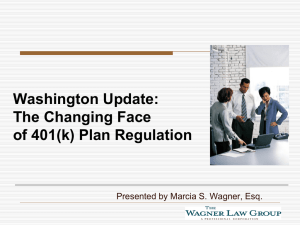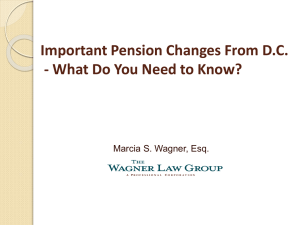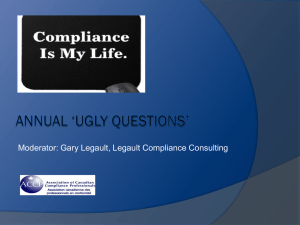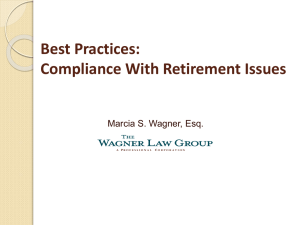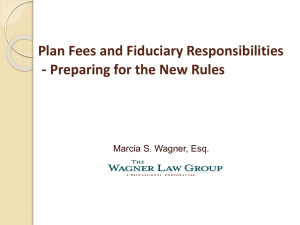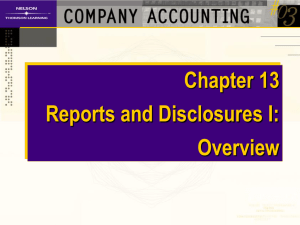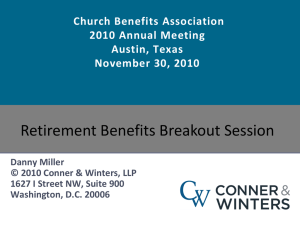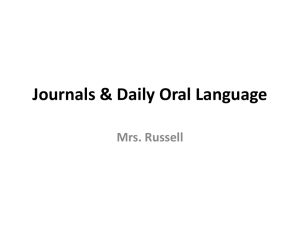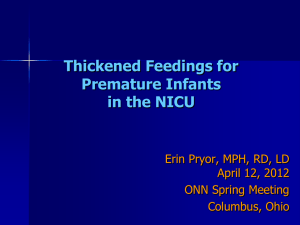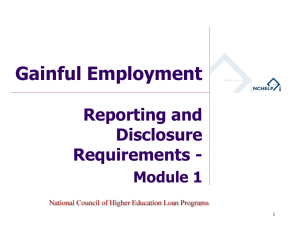ERISA Section 408(b)(2) Fee Disclosures
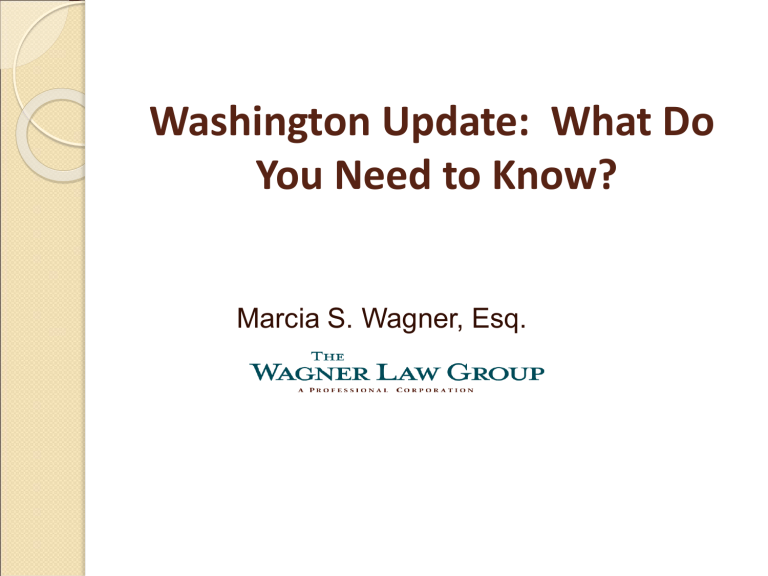
Washington Update: What Do
You Need to Know?
Marcia S. Wagner, Esq.
Priority Objectives from Washington
Outlook on U.S. Private Retirement System
◦
Retirement security remains a major priority.
◦
Pushing for reform through Congress and DOL.
White House Task Force on the Middle Class
◦
Newly created by President Obama in 2009.
◦
Chaired by Vice President Biden, and includes
Secretaries of Labor and Treasury.
◦
Used to coordinate Administration’s agenda.
Improving the DC Savings System
◦
Obama Administration’s proposals target 401(k) plans and providers.
◦
Blurring of lines between White House and DOL.
◦
Coordinated actions to improve retirement security.
2
1. Broader “Fiduciary” Definition
2. Fee Disclosures to Participants
3. 408(b)(2) Disclosures
4. Default Investments - TDFs
5. Lifetime Income Options
6. Automatic IRA Legislation
7. A Game Plan for Clients
3
ERISA and Conflicts
Fiduciary standards under ERISA are the highest known to the law.
◦
Conflicts can not be mitigated through disclosure.
◦
Must eliminate conflict or meet conditions of a PTE.
DOL’s current definition for investment advice is based on 5-factor test:
◦
Advice on value or advisability of investments,
◦ that is provided on a regular basis,
◦ pursuant to a mutual agreement or understanding,
◦ that such services will serve as a primary basis for investment decisions, and
◦ that individualized advice will be based on the particular needs of the plan.
4
Two Specific Changes Are Proposed
DOL releases proposed reg’s on Oct. 21, 2010.
◦
Proposed reg’s broaden existing regulatory definition of “investment advice fiduciary.”
Existing definition of investment advice requires:
◦
Mutual understanding or agreement that advice will serve as primary basis for plan investment decisions.
◦
Advice provided on regular basis.
DOL proposal for new investment advice definition merely requires:
◦
Any understanding or agreement that advice may be considered for plan investment decisions.
◦
Advice no longer needs to be provided on regular basis.
5
Safe Harbor for Avoiding Fiduciary Status
Proposed reg’s introduce new safe harbor.
◦
Non-fiduciary advisor must be able to demonstrate that plan client knows, or reasonably should know….
◦
…that advice is being made by advisor in its capacity as purchaser or seller of securities, and…
◦
…that advisor is not providing impartial investment advice.
2 specific activities are exempted under safe harbor.
◦
Non-fiduciary “investment education” under DOL
Interpretive Bulletin 96-1.
◦
Platform provider’s marketing of investment alternatives to plan (and providing related info) if it discloses that it is not providing impartial advice.
6
Potential Impact on Providers
Financial advisors - brokers
◦
Brokers would need to change their service model and re-define their role.
◦
If serving non-fiduciary role, must disclose they are not providing impartial advice.
◦
If serving fiduciary role, must avoid variable compensation (and prohibited transactions).
Other service providers
◦
Platform providers must disclose they do not provide impartial advice (to avoid fiduciary status).
◦
TPAs that provide advisory services in exchange for variable compensation must also provide disclaimer.
7
Outlook for DOL Proposed Reg’s
Proposal is consistent with Administration’s aim to reduce conflicts.
◦
If adopted, many advisors would be forced to adopt fee-leveling or change nature of advisory services.
Proposed reg’s expected to draw heavy comments.
◦
February 3, 2011 deadline for submitting written comments to DOL.
◦
Public hearing on March 1, 2011.
8
New Fiduciary Standards
Under Dodd-Frank Act of 2010
Dodd-Frank Wall Street Reform and Consumer
Protection Act of 2010.
◦
Empowers SEC to impose fiduciary standard on brokers with respect to retail clients.
◦
After completing its study on standards of care for brokers and RIAs on Jan. 21, 2011, SEC staff’s report recommends uniform fiduciary standard.
Financial advisors who are non-fiduciary brokers are currently subject to a duty of suitability only.
◦
SEC rulemaking may impose new disclosure obligations and fiduciary standards on brokers.
◦
SEC changes would be separate and in addition to
DOL changes to ERISA “fiduciary” definition.
9
1. Broader “Fiduciary” Definition
2. Fee Disclosures to Participants
3. 408(b)(2) Disclosures
4. Default Investments - TDFs
5. Lifetime Income Options
6. Automatic IRA Legislation
7. A Game Plan for Clients
10
DOL Finalizes Participant
Fee Disclosure Regulations
DOL issues final reg’s on Oct. 14, 2010.
◦
Generally consistent with 2008 proposed reg’s.
◦
DOL press release explained that existing law did not require plans to provide necessary information.
Types of plans covered
◦
New reg’s apply to DC plans with participantdirected investments.
◦
Covers plan even if not designed to comply with
ERISA Section 404(c).
Coverage of participants
◦
New reg’s apply to all eligible employees.
11
Annual and Quarterly Disclosure of Plan-Related Information
Must disclose general info about plan.
◦
Must include explanation of general admin. service
fees and individual expenses on annual basis.
◦
Must disclose dollar amount of fees/expenses charged to participant accounts on quarterly basis.
Disclosure only required for fees/expenses not embedded in expenses of investments.
◦
If service provider only receives indirect compensation from investments, provider’s fees are not subject to this disclosure requirement.
◦
But must disclose that a portion of general admin.
service fees is paid from expenses of investments.
12
Annual Disclosure of
Investment-Related Information
Must disclose fee and performance-related info for plan’s investment alternatives.
◦
This disclosure must be in comparative format.
◦
Must be provided on annual basis.
Required information for disclosure in comparative format includes:
◦
Name and type of investment option
◦
Investment performance data
◦
Benchmark performance data
◦
Total annual operating expenses for each investment and any extra shareholder-type fees.
◦
Internet website address
13
Other Requirements
Info that must be available upon request
◦
Prospectuses, shareholder reports and financial statements provided to plan.
Form of disclosure
◦
Separate or combined with SPD and/or statements.
◦
Must be understood by average participant.
Impact on sponsor’s other fiduciary duties
◦
No relief for duty to prudently select/monitor plan’s providers and investments.
◦
New reg’s modify ERISA 404(c) disclosures.
Effective date
◦
Plan years beginning on or after Nov. 1, 2011
14
Potential Impact on Providers
Administrative service providers
◦
New reg’s will impact TPAs and bundled providers.
◦
Automatic delivery of fund prospectuses will no longer be required under ERISA 404(c).
Financial advisors
◦
No special disclosure requirement for fees of brokers receiving indirect compensation only.
◦
RIA fees presumably must be disclosed on annual and quarterly basis as “general administrative” fee.
◦
Plan participants are likely to scrutinize plan’s investments and fees, impacting sponsors and advisors.
15
1. Broader “Fiduciary” Definition
2. Fee Disclosures to Participants
3. 408(b)(2) Disclosures
4. Default Investments - TDFs
5. Lifetime Income Options
6. Automatic IRA Legislation
7. A Game Plan for Clients
16
When Are Service Providers Conflicted?
Plan sponsor is looking for provider of administrative services.
Provider offers two options:
◦
Services ordered a la carte: $10,000.00
◦
Pre-packaged services and menu: $ 4,000.00
Plan sponsor may incorrectly conclude pre-packaged option is best for participants.
◦
Doesn’t realize that provider receives “hidden” compensation from funds and fund managers.
◦
Full compensation may be more than $10,000.
◦
Hidden cost is actually shifted to participants.
Provider has incentive to steer uninformed clients to more profitable option.
17
Retirement Security Initiative
Improving transparency of 401(k) fees.
◦
Administration’s goal is to make sure workers and plan sponsors are getting services at a fair price.
◦
Pushing to finalize DOL’s 2007 proposed reg’s this year.
Rationale for proposed 408(b)(2) reg’s.
◦
DOL efforts to educate plan sponsors about 401(k) plan fees started with Nov’ 97 hearing.
◦
Plan sponsors still not asking the right questions.
◦
DOL will now require providers to furnish the fee info sponsors should be requesting.
18
Covered Providers and Disclosures
Covered Service Providers
◦
Fiduciaries (including ERISA fiduciary or RIA).
◦
Providers of recordkeeping and brokerage services.
◦
Providers of accounting, actuarial, legal and other professional services if they receive indirect fees.
Required to disclose compensation in writing.
◦
Disclosure must be provided before entering into contract.
◦
Formal contract and disclosure of conflicts not required.
◦
Indirect compensation requires more detailed disclosure.
◦
Service-by-service disclosure of fees is generally not required.
19
Disclosure of Compensation
Format and manner of disclosure
◦
Dollar amount, formula, percentage of plan assets, per capita charge, or any other reasonable method.
◦
Whether fees will be billed or deducted and any other manner of receipt must be disclosed.
Compensation shared among related parties
◦
Generally, compensation paid to affiliates or subcontractors does not have to be disclosed.
◦
But must disclose if payment flows to related party on transactional basis (e.g., commissions, 12b-1 fees).
Special Rules for Platform Providers
◦
Must provide basic fee information for each investment alternative.
◦
Requirement can be met by passing through fund prospectuses.
20
Timing of Disclosures Under
Interim 408(b)(2) Regulations
Timing requirements for disclosures.
◦
Disclosure must be made reasonably in advance of entering into, extending or renewing services.
◦
Changes to information must be made no later than 60 days after provider becomes aware of change.
◦
Erroneous information will not result in a violation if provider has acted in good faith and with reasonable diligence.
◦
Errors and omissions must be disclosed within 30 days after coming to light.
21
Prohibited Transactions and
Interim 408(b)(2) Regulations
If provider fails to make disclosure, plan’s payment of fees is a prohibited transaction.
◦
Disclosure failures can be cured.
◦
Plan must make written request for information, and provider must respond within 90 days.
◦
Refusal or inability to comply with request requires plan fiduciary to notify DOL.
No conflicts of interest for fiduciaries.
◦
408(b)(2) disclosure does not cure self-dealing violations.
Outlook
◦
Effective date delayed from Jul. 16, 2011 to
Jan. 1, 2012, but further changes may be on horizon.
22
1. Broader “Fiduciary” Definition
2. Fee Disclosures to Participants
3. 408(b)(2) Disclosures
4. Default Investments - TDFs
5. Lifetime Income Options
6. Automatic IRA Legislation
7. A Game Plan for Clients
23
Background on Target Date Funds
Popular default investment vehicle for 401(k) plans.
Typically, formed as open-end investment companies registered under the Inv. Co. Act.
Defining characteristic – “glide path” which determines the overall asset mix of the fund.
Performance issues in 2008 raise concerns, especially for near-term TDFs.
◦
Based on SEC analysis, the average loss for TDFs with a 2010 target date was -25%.
◦
Individual TDF losses as high as -41% .
24
Recent Developments for TDFs
DOL and SEC at Senate Special Committee on
Aging hearing on TDFs (Oct. 28, 2009).
◦
Investor Bulletin jointly released by DOL and SEC.
◦
DOL’s fiduciary checklist on TDFs is pending.
SEC proposal for TDF advertising materials.
◦
If name has target date, “tag line” disclosure needed.
◦
Advertising must include glide path information.
On Nov. 30, 2010, DOL proposes rules on TDF disclosures for participants, amending:
◦
QDIA reg’s issued under PPA of 2006
◦
Participant-level fee disclosure reg’s that were finalized on Oct. 14, 2010 but are not yet effective.
25
DOL’s Proposed Changes to QDIA Reg’s
Background on QDIA Reg’s
◦
Participant deemed to be directing investment to default choice if QDIA requirements are met.
◦
Default investment must be a QDIA, and QDIA notices must be provided to participants.
DOL proposes change to QDIA notice for TDFs.
◦
Explanation and illustration of TDF’s glide path.
◦
Relevance of target date (e.g., 2030) in TDF name.
◦
Disclaimer that TDF may lose money after retirement.
DOL also proposes general changes to QDIA notice (even if not a TDF).
26
DOL’s Proposed Changes to
Participant-Level Fee Disclosure Reg’s
Background (recap)
◦
New rules will require disclosure of plan-related fees and annual comparative chart for plan’s investments.
DOL proposes change to annual comparative chart for TDFs (even if not a QDIA).
◦
Must include appendix with additional TDF info.
◦
Same info as required for QDIA notice.
Informal follow-up guidance from DOL
◦
TDF prospectus is unlikely to satisfy QDIA notice and annual comparative chart requirements, as proposed.
◦
DOL will not provide “model” target date disclosures.
27
Conflicts of Interest in TDFs
Conflicts arise when a “fund of funds” invests in affiliated underlying funds.
◦
Conflicts are permitted because fund managers are carved out from ERISA’s fiduciary requirements.
Are fund managers ever subject to ERISA?
◦
Firm requested clarification on scope of carve-out.
◦
In Adv. Op. 2009-04A (Avatar Associates), DOL declined to rule that the TDF managers are fiduciaries.
Implications of DOL guidance
◦
Plan sponsors are alone in their fiduciary obligation.
◦
Must ensure TDFs (and underlying funds) are appropriate plan investments.
28
Congressional Proposal for TDFs
Senator Kohl announced his intent to introduce new legislation (Dec. 2009).
◦
Concerns over high fees, low performance or excessive risk in many TDFs.
◦
Would impose ERISA fiduciary status on TDF managers when TDF used as QDIA in 401(k) plans.
Senator Kohl’s proposal differs from DOL approach to improve disclosures to employers and participants.
29
1. Broader “Fiduciary” Definition
2. Fee Disclosures to Participants
3. 408(b)(2) Disclosures
4. Default Investments - TDFs
5. Lifetime Income Options
6. Automatic IRA Legislation
7. A Game Plan for Clients
30
Retirement Security and Annuitization
Obama Administration believes lifetime income options facilitate retirement security.
◦
Initiative to reduce barriers to annuitization of 401(k) plan assets.
◦
DOL / IRS issued a joint release with requests for information on Feb 2, 2010.
◦
RFI addresses education, disclosure, tax rules, selection of annuity providers, 404(c) and QDIAs.
The Retirement Security Project
◦
Released 2 white papers on DC plan annuitization.
◦
Proposed use of annuities as default investment.
31
Other Recent Developments in DC Plan Annuitization
Two types of legislative proposals.
◦
Encourage annuitization with tax breaks: Lifetime
Pension Annuity for You Act, Retirement Security
for Life Act.
◦
Annual disclosure of what 401(k) plan balance would be worth as annuity: Lifetime Income
Disclosure Act.
IRS addressed qualification requirements for DC plans in PLR 200951039.
◦
Variable group annuity investment options
◦
No “surprise” interpretations on age 70 ½ minimum distribution and QJSA rules.
32
Lifetime Income Hearing by
Senate Special Committee on Aging
Senate hearing held on June 16, 2010.
◦
The Retirement Challenge: Making Savings Last a
Lifetime.
◦
Start of legislative debate on lifetime income options.
DOL and Treasury provide early analysis on
RFI concerning lifetime income options.
◦
More than 800 responses to RFI.
◦
Concerns expressed against government takeover of 401(k) plans.
◦
DOL and Senator Kohl clarify that there is no interest in mandating lifetime income options.
33
Joint Hearing by DOL, IRS and
Treasury in September 2010
Purpose is to investigate 5 focused topics.
2 areas of general policy-related interest.
◦
Specific concerns raised by participants.
◦
Alternative designs of in-plan and distribution lifetime income options.
3 areas of specific interest.
◦
Fostering “education” to help participants make informed retirement income decisions.
◦
Disclosure of account balances as monthly income streams.
◦
Modifying fiduciary safe harbor for selection of issuer or product.
34
1. Broader “Fiduciary” Definition
2. Fee Disclosures to Participants
3. 408(b)(2) Disclosures
4. Default Investments - TDFs
5. Lifetime Income Options
6. Automatic IRA Legislation
7. A Game Plan for Clients
35
Automatic IRA Legislation Proposed
Automatic IRA Act of 2010 introduced in both
Senate and House.
Senate version introduced on Aug. 6, 2010.
◦
After phase-in period over 4 years, employers with 10 or more employees must set up Auto IRAs.
◦
Covers all employees who are age 18 with 3 months.
◦
Choice of Traditional or Roth IRA (Roth is default).
◦
Investment firms not required to sell Auto IRAs.
◦
3 investment options only, which must be low-cost.
◦
Noncompliance results in$100-per-employee penalty.
◦
New tax credit for small employers of $250 for startup costs, and $1,000 tax credit for 401(k) plans.
36
Automatic IRA Legislation Proposed
House version introduced on Aug. 10, 2010.
Differences from Senate version.
◦
All employers with 10 or more employees are immediately covered (and no phase-in over 4 years).
◦
Default choice for employee is Traditional IRA (and not
Roth IRA).
◦
3 investment options for Auto IRAs are somewhat different than in Senate version.
White House’s 2012 budget proposal includes
“Automatic Workplace Pensions” initiative.
◦
Automatic IRA legislation remains high priority for
Obama Administration.
37
1. Broader “Fiduciary” Definition
2. Fee Disclosures to Participants
3. 408(b)(2) Disclosures
4. Default Investments - TDFs
5. Lifetime Income Options
6. Automatic IRA Legislation
7. A Game Plan for Clients
38
Final and Proposed Rules
Will Impact Many Plan Clients
408(b)(2) Fee Disclosures
◦
Providers must furnish detailed fee disclosures by Jan.
1, 2012.
◦
Will also impact plan sponsors directly.
Plan sponsors have duty to ensure plan’s fees are reasonable under ERISA.
◦
Duty will extend to fee information included in providers’ 408(b)(2) disclosures.
◦
Sponsors are likely to need assistance in light of complexity of plan arrangements.
◦
Advisors can assist in prudent evaluation of fees and, if necessary, in search for alternative arrangements.
39
Fee Disclosures to Participants
Many participants may be caught off guard by fee disclosures under the new rules.
◦
New rules become effective January 1, 2012 for calendar year plans.
Advisors can help plan sponsors prepare.
◦
Discuss with plan’s recordkeeper and determine impact of new rules on existing fee disclosures.
◦
Meet with participants and review fee information through educational sessions.
◦
If sponsor has fee-related concerns, remind sponsor that its fiduciary review process can be enhanced.
40
Target Date Disclosures
Provide meaningful TDF disclosures to participants as a “best practice” right now.
◦
Provide key information about TDF’s glide path, landing point and potential volatility.
Also facilitate sponsor’s prudent review of the plan’s TDF series.
◦
Assist in the fiduciary review of the “fund of funds” structure, glide path, underlying funds and risk.
◦
Special review of TDFs for participants in or nearing retirement (e.g., 2015 TDF).
41
A0049764
Washington Update: What Do
You Need to Know?
Marcia S. Wagner, Esq.
99 Summer Street, 13 th Floor
Boston, MA 02110
Tel: (617) 357-5200 Fax: (617) 357-5250
Website: www.erisa-lawyers.com
marcia@wagnerlawgroup.com
42

